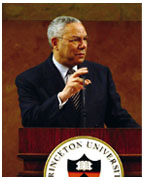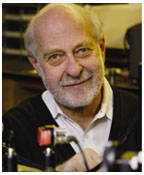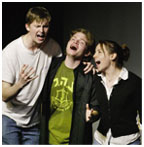March 10, 2004: Notebook
Symphony
of light
Tuning lasers to manipulate molecules
Christopher Eisgruber ’83 to be new provost

|
Colin Powell recalled letters he received from George Kennan ’25, during a campus visit February 20. (Denise Applewhite) |
Secretary of State Colin Powell warned of the dangers of the proliferation of weapons of mass destruction and defended the Bush administration’s actions in Iraq during a visit to campus February 20. Powell spoke about security and international relations in the post-September 11 world as part of a conference paying tribute to George F. Kennan ’25, a major figure in Cold War foreign policy.
In his keynote address, Powell promoted “tough-minded diplomacy” as the best tool to deal with nuclear weapons programs in North Korea, Iran, India, and Pakistan. He also said the absence of weapons stockpiles in Iraq does not get Saddam Hussein’s regime off the hook. “They never lost the intention to have such weapons,” he said.
Powell’s address began with recollections of his own interaction with Kennan, who developed the United States’ “containment” doctrine. When Powell took office in 2001, Kennan wrote to him to offer practical advice. Powell thanked him and encouraged him to write again, to which Kennan replied, “I’m 97 years old. I do not intend to write you letters on a regular basis.” Nevertheless, another letter arrived in Powell’s mailbox a few months later. Kennan, who turned 100 on February 16, was unable to attend Powell’s speech.
Answering questions after his address, Powell, a retired four-star general
and former chairman of the Joint Chiefs of Staff, said that improving
the human condition by fighting poverty, starvation, and AIDS is the ultimate
goal of global democracy. Representatives of the undergraduate student
body presented Powell with the inaugural Crystal Tiger Award, to be awarded
to public figures who have “improved society and strengthened our
values.” He vowed to display it on his desk to impress visitors such
as Donald Rumsfeld ’54 and George Shultz ’42. ![]()
By B.T.

|
Photo: Using differently shaped laser pulses, Herschel Rabitz can perform thousands of experiments in minutes. (Frank Wojciechowski) |
Tuning lasers to manipulate molecules
For four decades, chemists and physicists have been working with lasers to manipulate molecules with a distant dream in mind: selectively cutting and pasting atoms to create molecules that could not be made easily in a traditional chemical laboratory. That dream is still alive, according to Professor Herschel Rabitz, an innovator in the field, and fascinating advances are bringing scientists closer to the goal.
Rabitz, the Charles Phelps Smyth ’16 *17 Professor of Chemistry, likes to explain lasers in musical terms. Each ultrafast laser pulse, he says, is like a symphony, with hundreds of varied tones. When the right pulse is paired with the right molecule, the molecule responds. “The pulse is oscillating back and forth, so it’s pushing and pulling on the molecule, all of the bonds at once, in some kind of orchestrated atomic dance,” Rabitz says.
Since the advent of laser technology in the 1960s, scientists have been trying to selectively cut apart molecules with lasers, but the required complex laser pulses are a relatively new creation. With early lasers, it was impossible to break one bond without affecting the others. “Energy would go to the right place, but it would be redistributed rapidly, destroying the selectivity of the process,” Rabitz says. “What would happen, if anything, was the weakest bond would break, which is the same outcome that you would have if you put a Bunsen burner under it.”
To make finely tuned pulses possible, Rabitz turned to engineering. In the late 1980s, when most chemists had grown frustrated with the idea of using lasers as a type of molecular-scale scissors, Rabitz approached the question of laser effectiveness as a control-theory problem. Ultrafast laser-pulse shaping technology, created by the telecommunications industry for fiber-optic transmissions, enabled Rabitz to test his control theories. By shooting molecules with a series of differently shaped pulses and recording how the molecules reacted, he surmised, you could home in on an ideal pulse. Because the laser pulses last just one-trillionth of a second, and the apparatus can change rapidly from one pulse shape to another, Rabitz found it was possible to perform thousands of different experiments in minutes.
Six years ago, researchers began to selectively break apart molecules, and now, 30 to 40 laboratories are able to use shaped laser pulses in this fashion. Potential applications include production of complex molecules (in small quantities) and detection of chemicals in the air. Beyond chemistry, more possible uses have surfaced, such as employing shaped laser pulses to create ultrafast switches in semiconductors or as driving components of quantum computers. “Anything you can think of that involves manipulation at the molecular scale is, in principle, possibly amenable to this,” Rabitz says.
While Rabitz is encouraged by the potential and the emerging successes
in the laboratory, he has become more interested in how and why the laser
pulse experiments work. His recent research indicates that the answers
to these questions lie in some fundamental aspects of quantum mechanics.
Predominantly a theoretician, he also operates a laboratory program at
Princeton. Rabitz believes there is an underlying organization to how
shaped laser pulses act, suggesting they may be thought of as photonic
reagents with properties that can be categorized, like ordinary chemical
reagents. He also plans to take a new approach, using the laser pulses
to manipulate molecules without breaking the bonds between atoms. By doing
so, he hopes to gain insights into the underlying quantum mechanical aspects
of how photonic reagents operate. ![]()
By B.T.

Princeton professor Christopher Eisgruber ’83, a Constitutional scholar and director of the Program in Law and Public Affairs, will become the University’s provost July 1. He replaces Amy Gutmann, who has been named president of the University of Pennsylvania.
Eisgruber, the Laurance S. Rockefeller Professor of Public Affairs in the Woodrow Wilson School and the University Center for Human Values, joined Princeton’s faculty in 2001, and has taught courses on the Supreme Court, law and public policy, and international human rights. He served in 2002—03 as acting director of the Program in Ethics and Public Affairs.
President Tilghman said Eisgruber is known for “his creativity, his intellectual curiosity, his colleagueship, his commitment to high standards, and his sound judgment.”
A physics major, Eisgruber earned an M.Litt. in politics as a Rhodes
scholar at Oxford University and a law degree at the University of Chicago
Law School. After clerking for U.S. Supreme Court Justice John Paul Stevens,
he taught at the New York University School of Law. Author of Constitutional
Self-Government (2001), he has testified before federal and state legislators
on issues related to religious freedom. Eisgruber has served as faculty
representative on the Alumni Council Execu-tive Committee, and recently
cotaught an alumni studies course.
As Princeton’s second-ranking official, Eisgruber will serve as the
president’s deputy. ![]()
By B.T.
|
(Photo: Frank Wojciechowski) |

Quipfire!, Princeton’s student improvisation group, gave three performances
February 14 and 15. Here, from left, Cody May ’07, Matt Schonfield
’04, and Carolyn Pichert ’05 play the game Musical Revue, creating
songs for the not-yet-ready-for-Broadway musical African Safari Gone Bad,
at the suggestion of the audience. ![]()

|
Nate Domingue ’06, right, and Robert Moore ’06 hit the Internet big-time with their “Generic Rap Song.” (Frank Wojciechowski) |
Most rap singers need a recording contract and a promoter to get their songs played on the radio. For Nate Domingue ’06 and Robert Moore ’06, all it took was a 200-level English class and a Web site.
The two engineering students created a satirical rap song for a first semester course called “Dirty Words: Satire, Slander, and Society.” The original single, entitled “Generic Rap Song,” lampoons popular rappers such as 50 Cent, Ja Rule, P. Diddy, and Snoop Dogg. While the song was a joke, Domingue and Moore insist the course was not. They each wrote detailed papers explaining the subtleties of their satire for those not initiated into the rap scene.
In December, Moore posted the song and an accompanying music video on his Web site (www.princeton.edu/~rmoore/punit). Friends and newfound fans soon were linking to the track from Internet message boards. When a program director at Q106.1 FM in Jefferson City, Missouri, heard the song, he played it on the air and set up an interview with Domingue and Moore for the station’s morning show.
Through mid-February, Moore’s site had drawn more than 125,000
hits, averaging about 1,000 different visitors a day. Frequent downloads
of the music video file occupied up to 80 percent of the University’s
daily bandwidth, forcing Moore to seek out other sites to “mirror”
the file. Domingue and Moore say the logical follow-up to “Generic
Rap Song,” would be a generic remix, but with a new semester in full
swing, they have little time for recording. “It’s difficult
to justify doing the things you enjoy when there’s so much work to
do,” Moore says. “Doing it for a class made it a lot easier.”
![]()
By B.T.

|
(Photos: PAUM) |
Three paintings recently donated to the Art
Museum are on display through July 11. Two, portraits of Tsarevich
Paul (left), and his wife, Maria Fedorovna, are by Alexander Roslin, who
was invited by Empress Catherine II to St. Petersburg in 1775 to paint
members of the Russian nobility. The third, a portrait of Maria Theresa
of Austria, was painted by Martin van Meytens in the 1740s. ![]()

As society becomes increasingly diverse, are citizens enjoying less equality and community than before? According to Robert Putnam, public policy professor at the John F. Kennedy School of Government and author of the headline-making Bowling Alone (2000), the answer is an emphatic yes.
The relationship between diversity and community is a major problem for the 21st century, he said, and “we must understand how to foster both.”
Speaking February 12, Putnam presented unpublished results suggesting that ethnic and socioeconomic diversity may be a factor in the recent decline of civic engagement. “Civic disengagement in America and how we can reverse it is a challenge that will occupy all of us in the coming decades,” he said.
The experience of suffering has been dehumanized by modern medicine,
says Arthur Kleinman, professor of anthropology at Harvard. Kleinman,
a leading researcher in crosscultural psychiatry, said February 16 that
we are in the midst of a “shifting cultural representation”
of mental illness and suffering. The “vast phenomenon of medicalization”
that characterizes technological medicine has encouraged society to view
people’s mental and social conditions as pathology. “Suffering
has been stripped of its human element and converted into an object of
pharmacological and technical intervention,” he said. ![]()
By Jordan Paul Amadio ’05
Web talks
www.princeton.edu/webmedia/lectures
K. Anthony Appiah, Princeton professor of philosophy: “Ethics of Identity.” December 10, 2003.
Elizabeth Fox-Genovese, professor of the humanities, Emory University: “Marriage on Trial, Marriage 101, Marriage 102.” December 2003.
Vera Rubin, Carnegie Institution of Washington: “Telling Stories about the Universe.” December 4, 2003.

When recommending a budget increase for graduate-student assistants in instruction (A.I.s) in January, the Priorities Committee noted that Princeton undergraduates increasingly are taking more than the required course load each semester. Toni Turano, associate dean of the faculty, noticed the trend when A.I. hours began to exceed the budget, despite a virtually constant student population. Excluding freshman seminars and writing seminars, total course enrollment jumped 3 percent in 2001—02 and another 0.8 percent in 2002—03. Turano estimates that one in four A.B. students takes more than the standard eight courses per year.
An exhibit celebrating Reunions is on view through July 15 at Mudd Manu-script Library. “Princeton Reunions and the P-rade: A Historical Retrospective” offers a photographic timeline and a selection of artifacts from the 19th century to the present. Complementing the show is an online exhibit, which can be seen at http://infoshare1.princeton.edu/libraries/firestone/rbsc/mudd/online_ex/reunions/index.html.
Mathematics professor Joseph Kohn *56 has been selected by the American Mathematical Society to receive the 2004 Stefan Bergman Prize for his research in partial differential equations and complex variables. Kohn has been a professor at Princeton since 1968 and is a former chairman of the math department.
The American Geophysical Union has awarded its 2004 Macelwane Medal to geoscientist Daniel Sigman for his work in understanding the role of nitrogen in oceans. Sigman, assistant professor of geosciences, came to Princeton in 1998 as a postdoctoral fellow and joined the faculty in 2000.
The Board of Trustees has appointed three new faculty members as full professors. They are: Christopher Achen, professor of politics; Susan Stewart, professor of English; and Ned Wingreen, professor of molecular biology.
Achen specializes in applying mathematical and statistical theory to electoral and party systems, public policy, and international relations. He earned his Ph.D. from Yale.
Stewart specializes in 20th-century British and American literature and culture. She earned her Ph.D. from the University of Pennsylvania.
Wingreen’s research focuses on quantitative models of real biological systems, about which he has written numerous articles. He also has been issued three patents for his research. He earned his Ph.D. from Cornell University.
The Board of Trustees has approved the promotions of seven faculty members. Margaret Martonosi, in electrical engineering; Allan Rubin, in geosciences; and Michael Strauss, in astrophysical sciences, have been promoted to professor.
Goran Blix, in French and Italian; Kosuke Imai, in politics; Tymon Tatur,
in economics; and Benjamin Widiss, in English, have been promoted to assistant
professor. ![]()






